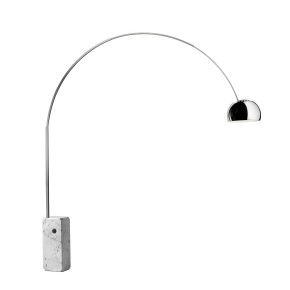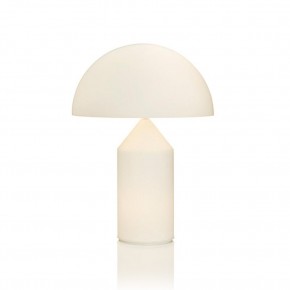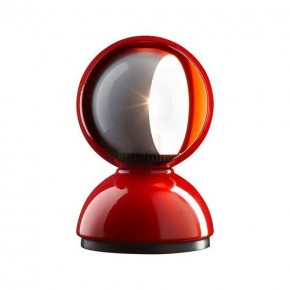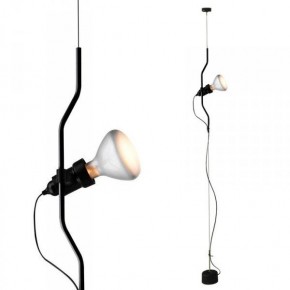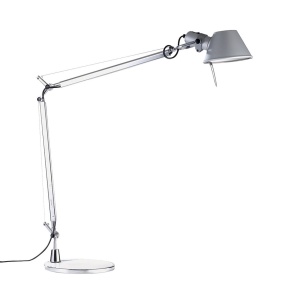- Lighting
- 4640 views
The great classics of design never go out of fashion: even if created in the last century, the avant-garde style of some lamps has made them famous design icons, so much so that they are still produced today by the main lighting brands.
They have inspired and innovated but, above all, they left a mark by becoming part of the collective imagination, writing the history of design. Impervious to the passage of time, fashions and social changes, these iconic lamps are born from the pencil of the most important designers in the lighting sector, including Achille and Pier Giacomo Castiglioni, Vico Magistretti, Gio Ponti, Richard Sapper, Pio Manzu, ...
Nowadays they’ve become indispensable objects for design lovers, fundamental elements in the living environment, able to radically transform the perception of spaces thanks to their shapes and light sources.
Below we tell the story of 6 of the most famous historical design lamps, all available in our online store.
ATOLLO – Vico Magistretti for Oluce
![]()
Atollo, designed by Vico Magistretti for Oluce in 1977, transforms a functional domestic object into an abstract sculpture with perfect proportions. Archetype of the modern lamp, it is part of the Permanent Collection of Italian Design 1945-1990 at the Triennale of Milan. It is decorated with two distinct elements, connected by a very thin element, which creates infinite light and shadows effects. The conical cylinder has a wide base to increase its stability, and supports the weight of the upper cupola, almost a reinterpretation of the fabric lampshades. The Atollo design lamp is available in three different sizes and in different finishes: gold, white or black metal and opal glass.
TIZIO – Richard Sapper for Artemide
![]()
An innovative idea, a good design, the harmony between form and function and the quality/price ratio: many are the elements that make the (lasting) success of a product. The award-winning Tizio table lamp includes them all. It was created for Artemide in 1972 by the German naturalized Italian designer Richard Sapper. The concept is simple: a desk lamp with direct light, whose base does not take up much space and is adjustable. But what characterizes it more than anything else is the total absence of electrical cables. The current, in fact, passes through its arms that act as conductors. The very good insulation prevents it from taking a jolt. This lamp has the peculiarity of being completely articulated, so you can assume many positions with the touch of a finger, thanks to a balanced game of counterweights.
ECLISSE – Vico Magistretti for Artemide
![]()
Vico Magistretti says he designed the Eclisse lamp while in Milan and drew it on the back of a metro ticket in 1965. His inspiration came from the lamp used by Jean Valjean in Victor Hugo's Miserables. Three hemispheres: two fixed - the base and the outer shell - and a mobile one, the inner shell, inserted in the outer shell. The user becomes the protagonist, because he can modify the effect of light by moving the inner shell and darkening the bulb at will. Just like during an eclipse of the moon. A conceptual but also functional feature, which allows the object to be used as a direct or diffused light source as needed. The lamp is on display in the permanent collection of the Triennale Design Museum in Milan and the Museum of Modern Arts in New York.
ARCO - Achille e Pier Giacomo Castiglioni for FLOS
![]()
"We thought of a lamp that would project light onto the table: there were already, but we had to turn around." The challenge for the Castiglioni family was to get the light from above without having to put a chandelier on the ceiling or something big near a table. Pier Giacomo and Achille opted for materials already on the market and also studied the problem of the counterweight: instead of an initial block of cement, they preferred marble, because at the same weight it entails less space - and also a lower cost during the finishing work. This is how the iconic 65 kg block was created, with a hole to allow a broom handle to pass through it and allow the base to be lifted easily. Arco is one of the most famous and best-selling designer lamps in the world and is part of the permanent collection of the Triennale in Milan and MoMA in New York.
PARENTESI – Achille Castiglioni for FLOS
![]()
The Parentesi lamp, inspired by an idea sketched by Pio Manzù, is a mechanism based on the friction between two parts, summarizing the aesthetics of the necessary-and-sufficient. It is a very simple mechanism: a steel cable hooked to the ceiling and kept under tension through a lead counterweight; a steel tube in the shape of a parenthesis that runs along the wire; a lamp with a silver finish on the back, so as to direct the light without reflectors. "Formal minimalism must correspond to an idea, a concept, and since prehistoric times there has been this tendency to do the minimum, but in an ingenious and efficient way”. The lamp, rational and true representation of the principle form=function, won the XI edition of the Compasso d'Oro in 1979 and is currently exposed at the Design Museum of the Triennale in Milan.
TOLOMEO - Michele de Lucchi e Gianfranco Fassina for Artemide
![]()
Since 1987 the Tolomeo lamp has been able to face all trends and fashions, classifying itself as one of the timeless design objects and symbol of Made in Italy. For the development of the project's mechanisms, the contribution of Giancarlo Fassina, head of Artemide's technical department, was important, and De Lucchi decided to share his signature with him. Inspired by the fishing rods of the fishermen, who through tie rods and joints have created a perfect object with a solid structure and perfect balance. Pure and essential shapes characterize this lamp composed of a base, a polished aluminium disc, to which the lamp body is fixed. The presence of the spring balancing mechanism allows the infinite positions and makes it suitable for illuminating the work table. A unique design and so well done that, in 1989, he managed to win the renowned Compasso d'Oro. "Tolomeo is a formula, it is a product philosophy" described De Lucchi: the name of the lamp, in fact, comes from the astronomer and mathematician of ancient Greece, a suitable name for a lamp with a "scientific mentality". The success of this design icon continues today with an entire family of lamps and a production of half a million pieces per year.


